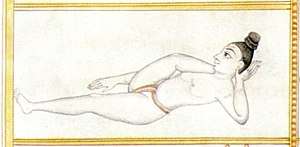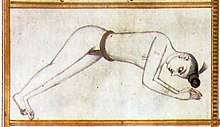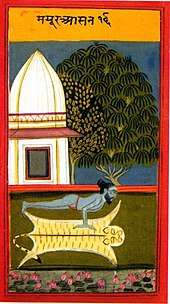Sritattvanidhi
The Sritattvanidhi (Śrītattvanidhi, "The Illustrious Treasure of Realities") is a treatise written in the 19th century in Karnataka on the iconography and iconometry of divine figures in South India. One of its sections includes instructions for, and illustrations of, 122 hatha yoga postures.

Authorship
The Sritattvanidhi is attributed to the then Maharaja of Mysore, Krishnaraja Wodeyar III (b. 1794 - d. 1868). The Maharaja was a great patron of art and learning and was himself a scholar and writer. There are around 50 works ascribed to him.[1] The first page of the Sritattvanidhi attributes authorship of the work to the Maharaja himself:
May the work Sri Tattvanidi, which is illustrated and contains secrets of mantras and which is authored by King Sri Krishna Raja Kamteerava, be written without any obstacle. Beginning of Shaktinidhi.[2]
Martin-Dubost's review of the history of this work says that the Maharaja funded an effort to put together in one work all available information concerning the iconography and iconometry of divine figures in South India. He asked that a vast treatise be written, which he then had illustrated by miniaturists from his palace.[3]
Contents

The resulting illuminated manuscript, which he entitled the Sritattvanidhi, brings together several forms of Shiva, Vishnu, Skanda, Ganesha, different goddesses, the nine planets (navagraha), and the eight protectors of the cardinal points (aṣṭadikpālas). The work is in nine parts, each called a nidhi ("treasure"). The nine sections are:[4]
Published editions
An original copy of this colossal work is available in the Oriental Research Institute, University of Mysore, Mysore. Another copy is in the possession of the present scion of the Royal Family of Mysore, Sri Srikanta Datta Narsimharaja Wadiyar. An unedited version of this work with only text in devanagari script was published about a century ago by Khemraj Krishna das of Sri Venkateshvar Steam Press, Bombay (Mumbai).
In recent times the Oriental Research Institute has published three volumes (Saktinidhi, Vishnunidhi, and Sivanidhi.[5] Prof. S.K.Ramachandra Rao, has edited a book titled "Sri-Tattva-Nidhi" (of Krishna Raja Wodeyar III of Mysore) (Vol-1). It was published by Kannada University, Hampi in 1993. However, in reality it was on Ragamala Paintings as depicted in "Svarachudamani" authored by the Mummadi Krishna Raja Wodeyar. Similar set of Ragamala Paintings are also found in Sri Tattva-Nidhi.
_from_Sritattvanidhi.jpg)
Another important work in this genre is by a Sanskrit scholar and hatha yoga student named Norman Sjoman. His 1996 book The Yoga Tradition of the Mysore Palace presents the first English translation of a part of kautuka nidhi, the Sritattvanidhi, which includes instructions for and illustrations of 122 postures, illustrated by stylized drawings of a yogini in a topknot and loincloth. Some of these poses—which include handstands, backbends, foot-behind-the-head poses, Lotus variations, and rope exercises—are familiar to modern practitioners (although most of the Sanskrit names are different from the ones they are known by today). But they are far more elaborate than anything depicted in other pre-twentieth-century texts. It also describes the origins of some asanas from a gymnastics exercise manual of the late 19th century, the Vyayama Dipika.[6]
Influence on modern yoga

In his 1996 book, Sjoman asserts that the influential yoga teacher Krishnamacharya, who did much to create modern yoga as exercise, was influenced by the Sritattvanidhi, which includes 122 asanas, some possibly based on gymnastics.[7]
See also
| Wikimedia Commons has media related to Sritattvanidhi. |
Notes
- mummaDi kRuShNarAja oDeyaru - oMdu cAriTrika adhyana by Dr. R.Gopal & Dr. S.Narendra Prasad,@page=92-94
- shrI kRuShNarAjamahArAjakaMThIravaviracitavAda, maMtrarahasyada shrItatvanidhiyeMba graMthavaM sacitravAgi bareyuvudakke nirviGnamastu.:atha shaktinidhiprAraMbhaH
- Martin-Dubost, op. cit.
- Sri Mummadi Krsihnaraja Wodeyar's 'Sritattvanidhi', Volume-1;shakti nidhi @ pages xviii-xxiv: by Oriental research Institute, University of Mysore, 1997
- Chief editor, M. Madaiah. Imprint: Mysore : Oriental Research Institute, University of Mysore. Physical Description: v. <1-3 > : col. ill. ; 29 cm. Series Information: (Oriental Research Institute series ; nos. <186, 194, 199 >) Volume Titles: v. 1. Saktinidhi -- v. 2. Visnunidhi -- v. 3. Sivanidhi / chief editor, K.V. Ramesh. Source of citation: DK Agencies, retrieved 1 March 2007.
- Sjoman 1999.
- Cushman, Anne (July–August 1999). "New Light on Yoga". Yoga Journal: 43. ISSN 0191-0965. Cite journal requires
|journal=(help)
References
- Chinmayananda, Swami (1987). Glory of Ganesha. Bombay: Central Chinmaya Mission Trust.
- Annals of the Mysore Royal Family , Part II. Mysore: Government Branch Press. 1922.
- Gopal, R.; Prasad, S. Narendra (2004). mummaDi kRuShNarAja oDeyaru - oMdu cAriTrika adhyana ( Mummadi Krsihnaraja Wodeyar- a Historic Study). Karnataka: Directorate of Archeology and Museums.
- Heras, H. (1972). The Problem of Ganapati. Delhi: Indological Book House.
- Krishan, Yuvraj (1999). Gaņeśa: Unravelling An Enigma. Delhi: Motilal Banarsidass Publishers. ISBN 81-208-1413-4.
- Martin-Dubost, Paul (1997). Gaņeśa: The Enchanter of the Three Worlds. Mumbai: Project for Indian Cultural Studies. ISBN 81-900184-3-4.
- Sjoman, Norman E. (1999) [1996]. The Yoga Tradition of the Mysore Palace (2nd ed.). Abhinav Publications. ISBN 81-7017-389-2.CS1 maint: ref=harv (link) Contains 20 color plate reproductions of 112 asanas reproduced from the Sri Tattvanidhi.
- Ramachandra Rao, S. K. (1992). The Compendium on Gaņeśa. Delhi: Sri Satguru Publications. ISBN 81-7030-828-3. Contains color plate reproductions of the 32 Ganapati forms reproduced from the Sri Tattvanidhi.
- Thapan, Anita Raina (1997). Understanding Gaņapati: Insights into the Dynamics of a Cult. New Delhi: Manohar Publishers. ISBN 81-7304-195-4.
- Wodeyar, Mummadi Krsihnaraja (1997). Sritattvanidhi. Oriental Research Institute, University of Mysore.
